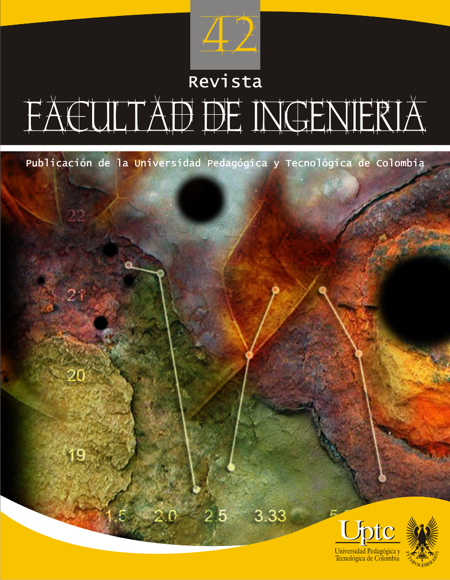Desarrollo de un método de simulación física de zonas térmicamente afectadas en soldaduras de acero, para estudios de propagación de grietas por fatiga

Resumen
Se presenta el desarrollo de un método de simulación física, a través del sistema Gleeble, de las zonas térmicamente afectadas de uniones soldadas de aceros estructurales (A283 Gr. C y A106 Gr. B), para el estudio de la propagación de grietas por fatiga. Para ello fue necesario utilizar probetas de 90 mm de largo, 49,5 mm de ancho y 7 mm de espesor, en una configuración que no se encuentra dentro de los estándares del sistema para este tipo de simulaciones. Con este método se reprodujeron satisfactoriamente, y por separado, en diferentes probetas del metal base correspondiente, la zona de grano fino, la zona de grano grueso y una zona de múltiples pasadas presentes en uniones soldadas fabricadas por FCAW. Las zonas simuladas fueron reproducibles, homogéneas, no presentaron defectos ni tensiones residuales y tuvieron un tamaño considerablemente grande, además que las características microestructurales (como el tamaño de grano y el porcentaje de fases) fueron muy similares a su contraparte real, lo que permitió estudiar por primera vez el efecto neto de la microestructura sobre el comportamiento a la fatiga en estas zonas. De esta manera, el desarrollo realizado permitió aumentar considerablemente las aplicaciones y las ventajas que esta técnica puede tener, además de mejorar la comprensión del comportamiento a la fatiga de las soldaduras de acero.
Palabras clave
propagación de grietas por fatiga, simulación física de la ZTA, uniones soldadas de aceros estructurales, variación microestructural en la ZTA
Citas
- J. Barsom and S. Rolfe, Fracture and fatigue control in structures: applications of fracture mechanics. United Kingdom: Butterworth-Heinemann, 1999. DOI: https://doi.org/10.1520/MNL41-3RD-EB
- D. F. Atehortua-López, “Propagación de grietas por fatiga en uniones soldadas por FCAW de aceros de bajo carbono y aceros de baja aleación y la aplicabilidad del ultrasonido como herramienta de monitoreo en este tipo de estudios”. Tesis de doctorado, Facultad de Ingeniería, Universidad del Valle, Cali, Colombia, 2016.
- T. Lassen and N. Recho, Fatigue Life Analyses of Welded Structures: Flaws. London: Wiley-ISTE, 2006. DOI: https://doi.org/10.1002/9780470612149
- ASM International Handbook Committee, ASM Handbook: Fatigue and Fracture, vol. 19, ASM International, 1996.
- Y. Adonyi, “Heat-Affected Zone Characterization by Physical Simulations”, Welding Journal, vol. 85 (10), pp. 42-47, Oct. 2006.
- J. A. Gianetto, F. Fazeli, Y. Chen et al., “Microstructure and Toughness of Simulated Grain Coarsened Heat Affected Zones in X80 Pipe Steels”, 10th International Pipeline Conference, Calgary, Canada, 2014. DOI: https://doi.org/10.1115/IPC2014-33254
- A. Polyakov, D. Gunderov, V. Sitdikov et al., “Physical Simulation of Hot Rolling of Ultrafine Grained Pure Titanium”, Metallurgical and Materials Transactions B, vol. 45 (6), pp. 2315-2326, Dec. 2014. DOI: http://dx.doi.org/10.1007/s11663-014-0133-9. DOI: https://doi.org/10.1007/s11663-014-0133-9
- M. Rahimian, S. Milenkovic, L. Maestro et al., “Physical Simulation of Investment Casting of Complex Shape Parts”, Metallurgical and Materials Transactions A, vol. 46 (5), pp. 2227-2237, May. 2015. DOI: https://doi.org/10.1007/s11661-015-2815-6
- Z. Gao and J. Niu, “Study on microstructure and impact ductility of simulated weld HAZ of high-strength wear-resistant steel NM360”, Reviews on advanced materials science, vol. 33 (3), pp. 232-237, Nov. 2013.
- B. Liu, J. Qu and W. Sun, “Effects of thermal cycle on mechanical properties and fractography in HAZ of HQ130 steel”, Acta Metallurgica Sinica, vol. 17 (3), pp. 274-278, Jun. 2004.
- C. Zhou and C. D. Lundin, “A Comparison of Published Haz Thermal Simulation Methods Used to Derive Weld Haz Thermal Cycles”, Acta Metallurgica Sinica, vol. 13 (1), pp. 223-232, Feb. 2000.
- G. Atkins, D. Thiessen, N. Nissley and Y. Adonyi, “Welding Process Effects in Weldability Testing of Steels”, Welding Journal, vol. 81 (4), pp. 61s-68s, Apr. 2002.
- R. Blondeau, Metallurgy and Mechanics of Welding: Processes and Industrial Applications. London: ISTE Ltd. and John Wiley & Sons, Inc., 2008.
- G. E. Dieter, Mechanical Metallurgy: SI Metric Edition. Boston: McGraw-Hill, 1988.